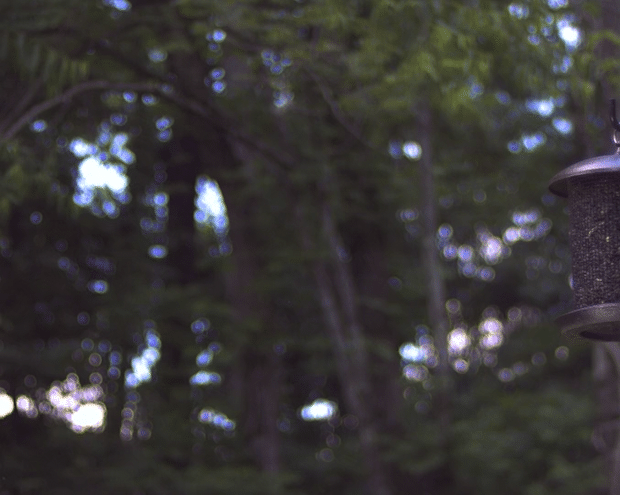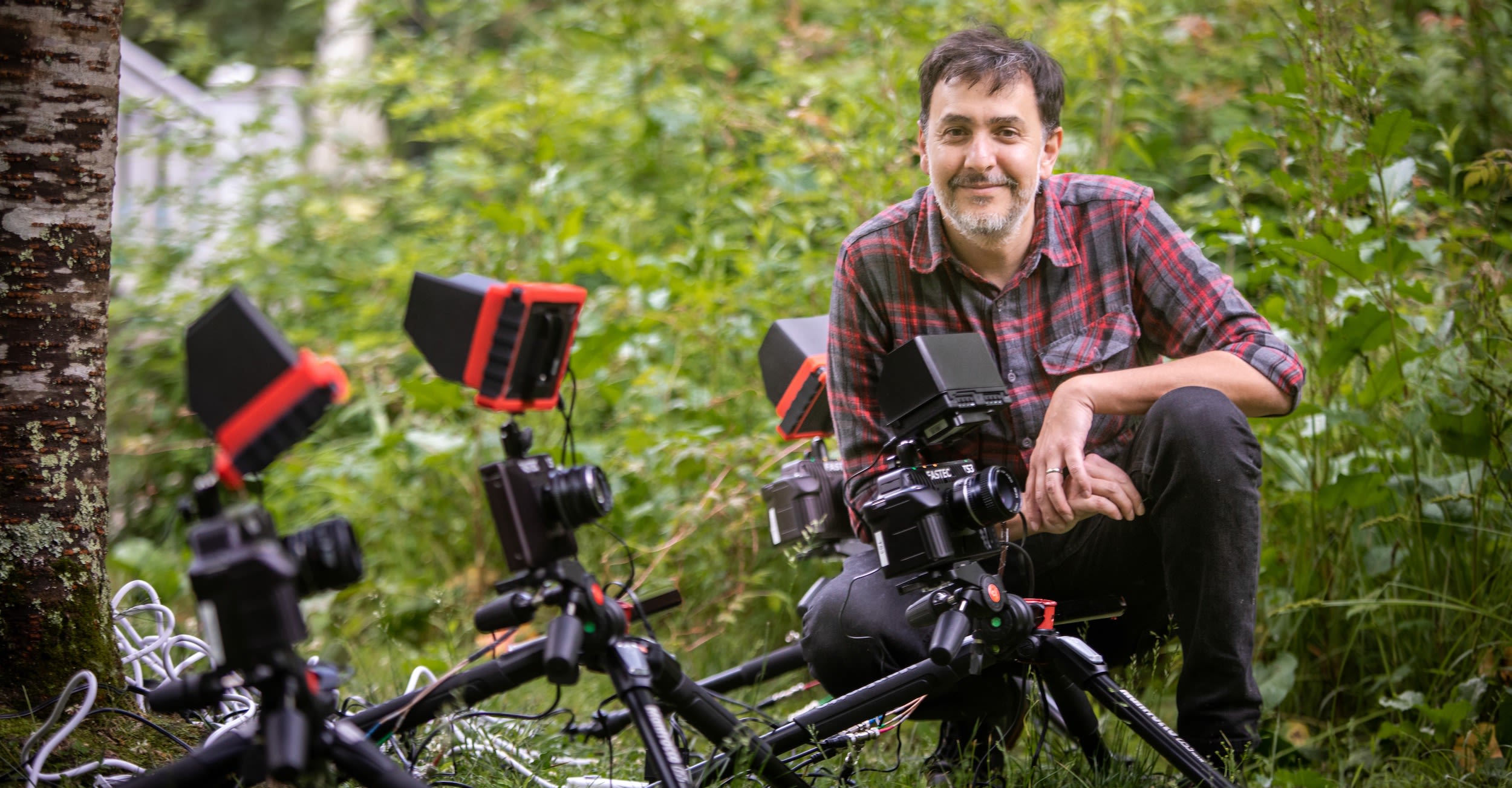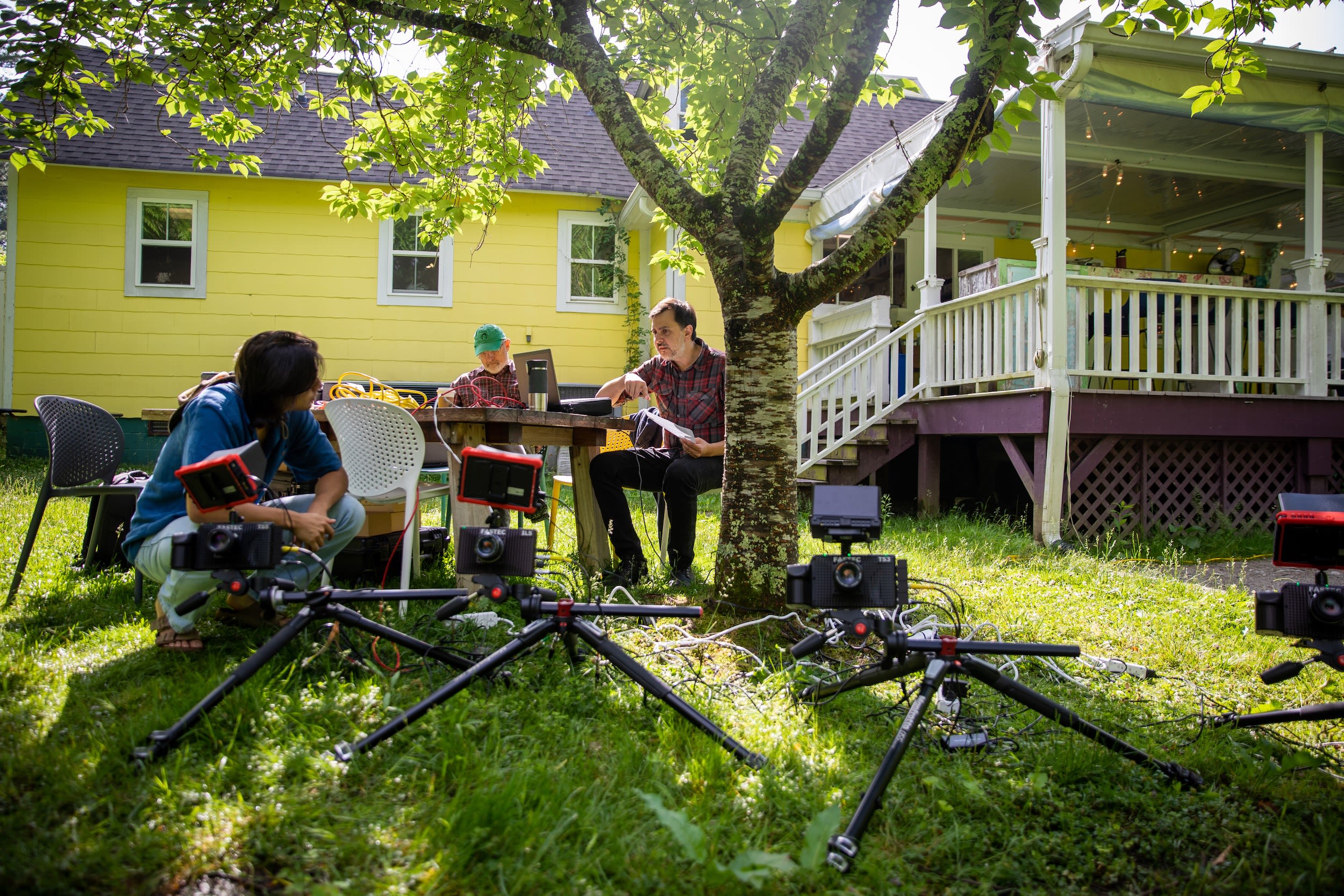What Can We Learn from the Nuthatch?
Using high-tech gear in a low-tech setting, a Sewanee biology professor and a student researcher study the intricacies of bird flight to make discoveries that could lead to aeronautical innovation.

“One of the cameras has gone offline,” says Will Holzer, C’23, working at a picnic table outside Stirling’s Coffee House in Sewanee with his professor, Jose “Pepe” Iriarte-Diaz. Before them, an array of four high-speed video cameras is pointed at one of the busy bird feeders in the marsh verge, surrounded by burdock and jewelweed. It’s a crazy hub of avian activity, and Iriarte-Diaz and Holzer are trying hard to capture it in order to discover the subtle ways different species of birds solve the complex problem of landing on a bird feeder.
Much of that commonplace task is difficult to discern in real time, and the research team’s synchronized cameras, capturing flight at the rate of 200 frames per second, is giving them a chance to study the subtleties—that is, if they can work out the technical difficulties.
“We’ve been practicing,” says Holzer.
Iriarte-Diaz explains: “Last summer, we would spend up to three hours setting up the cameras. We needed to get faster, so we have been in the lab, setting them up over and over.”
Indoors, they could set up the data collection system in less than two hours, but on the first day in the field it takes a little longer, as they have to battle real-world conditions such as cables running through damp grass and ever-changing natural light. The cameras have to be synchronized and have to be pointing at the very same field of view, tasks Iriarte-Diaz accomplishes by lining the field of view up with a checkerboard camera calibration target and a tennis ball, which he drops into the burdock to establish the vertical axis.
Iriarte-Diaz is fascinated by the diversity of animal movement, from the flight of bats to the mastication of primates. “Animals can do amazing things that we cannot do,” he says. “How do cats jump? How do birds fly? That always fascinated me, and I’ve wondered what we can learn from these animals.” His project is likely the first research on biomechanics to be conducted at Sewanee.

Pepe Iriarte-Diaz with his array of high-speed cameras, which capture video at 200 frames per second.
Pepe Iriarte-Diaz with his array of high-speed cameras, which capture video at 200 frames per second.
While Iriarte-Diaz had always been interested in animal movement, his career in biomechanics turned on a scientific paper he read when he was an undergraduate at Universidad de Chile. “It was a paper on the allometry of long bones and how they relate to changes in posture and locomotion,” he says. “You can think of allometry as the scaling of a structure—how it changes with size.” Reading that paper was a gateway to biomechanics, even though no one else in Chile was studying in the field at the time.
After completing undergraduate studies, Iriarte-Diaz started a master’s program, and his research studied the running of rodents. “I became the de facto biomechanics expert,” he says. That is when an undergraduate student approached him for an idea about a research project and, together, they came up with an idea for improving on a previous experiment by another researcher who wanted to study dinosaur locomotion. Knowing that birds evolved from dinosaurs, the previous researcher attached weights to the tails of chickens. “As birds evolved, the animals’ center of mass moved forward,” says Iriarte-Diaz. “The weight distribution shift changed the gait of the animals.” The first researcher attached weights to the tails of chickens to see if that would change the way they walked. Instead, they simply sat down, a desultory response to the unexpected weight.
“We knew we could do better,” says Iriarte-Diaz, and the solution was to begin giving chickens artificial tails as hatchlings, every week weighing the subjects and attaching an artificial tail of proportionate weight and size to mimic dinosaur dimensions.
And it worked. The chickens’ stride became longer, recruiting more of the leg in the act of walking than unmodified chickens do, essentially demonstrating how dinosaurs were thought to have walked. “This was my most famous paper,” laughs Iriarte-Diaz. Fame for the work came when the Annals of Improbable Research, a satirical scientific journal published at Harvard awarded the project its IG Nobel Prize, for a paper that makes you laugh and then makes you think. “It’s a wonderful, fun prize ceremony,” says Iriarte-Diaz, “and everyone gets into the spirit of the event.” As evidence of the fun, the research team accepted the prize on stage with plungers taped to the seat of their pants.
At Stirling’s, it’s not all business. After the laborious work of setting up the cameras, Iriarte-Diaz and Holzer settle back to gather data. The cameras hold seven seconds of video recording in a buffer. Each time a bird lands on the feeder, a researcher will press a button that saves the last second and a half to a high-capacity memory card. They are capturing what they call “trials,” or a successful landing on the feeder. By the end of day four of recording, they have 500 trials. And in the meantime, they talk over coffee and smoothies.
Later, back in the laboratory, the researchers will go over the data, tracking the bird’s flight, frame by tedious frame, marking “landmarks,” or the location of parts of birds—the head, the wingtips, the feet, the end of the tail, and the like. When all the trials have been coded, they will be able to build models of the bird flight and make interspecific comparisons. How do red-bellied woodpeckers land compared with tufted titmice or northern cardinals? How are their solutions similar?
Two finches land on a feeder at Stirling's. Video by Pepe Iriarte-Diaz.
Two finches land on a feeder at Stirling's. Video by Pepe Iriarte-Diaz.
Iriarte-Diaz is particularly interested in the flight of white-breasted nuthatches, which remind him of the bats he studied as a graduate student at Brown University. He demonstrates with his arms and body: “Bats land upside down. When they approach the place they are going to land, they tuck their wings to gain angular velocity, like a figure skater does. That spins them around and they can grasp their landing point.” Iriarte-Diaz had noticed a similar movement with the nuthatches at his bird feeder at home and was intrigued. He wondered if they used the same strategies. The nuthatches at Stirling’s do not cooperate, landing like common woodpeckers.
The study of biomechanics is essentially the study of adaptation in action, and Iriarte-Diaz’s research has had to adapt as well. At Brown, he had access to a magnificent wind tunnel used jointly by research universities in New England and managed by Harvard University. There, the camera setup was essentially permanent and the conditions controlled. No drastic changes from bright sunshine to cloud cover as in Sewanee. Researchers could gather data easily and focus on the analysis. “That was great to have that resource, but recording trials in a real-life setting such as a bird feeder at a coffee shop or watching from the comfort of your couch at home can really tell you a lot about various flight strategies birds use,” he explains.
The mysteries of bat flight turns out to be enormously important. The Aeromechanics and Evolutionary Morphology Lab in which Iriarte-Diaz worked as a graduate student was funded by the National Science Foundation and the U.S. Air Force, and the graduate students there worked side by side with engineering students in the Breuer Lab for advanced engineering research. That made connections between the basic research and its application efficient, with biologists discovering solutions to engineering problems by studying the animal world.

Will Holzer (left) and Pepe Iriarte-Diaz (right) work to get their cameras set up in the side yard of Stirling's Coffee House.
Will Holzer (left) and Pepe Iriarte-Diaz (right) work to get their cameras set up in the side yard of Stirling's Coffee House.
“Bats are efficient flyers,” Iriarte-Diaz explains. “They use less energy than other flying animals. Their wings are much more flexible and maneuverable than other animals’ wings.” Watch a bat some evening to grasp this concept. They juke like aerial running backs. And inquiring minds want to know how they do it. Professional conferences related to biomechanics draw thousands—the research community is not huge but the application potential of biomechanics research attracts avid interest.
A white-breasted nuthatch flies in from the right, landing like a titmouse. Unfortunately, the cameras are aiming at the left side of the birdfeeder. “I guess I will have to set up cameras at home and record the Monteagle nuthatches,” Iriarte-Diaz says with a smile. As the researchers were setting up, the birds were mauling the birdseed, but when they are ready to record, the feeding frenzy slows down. This is part of real life, too. Troubleshooting becomes a skill that students like Will Holzer learn when they get involved in research as undergraduates. Research in the field adds just the right amount of trouble, but when the field is at Stirling’s, there is a bit of comfort as well. As the lunch hour winds down in that interlude between the end of school and the start of summer programs on campus, the Iriarte-Diaz lab packs up, ready to transform trials into analyzed data to inspire the next aeronautical innovation.
